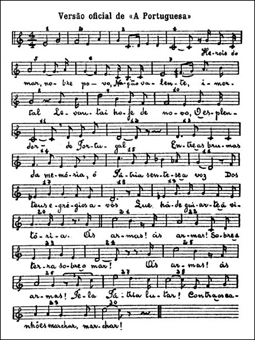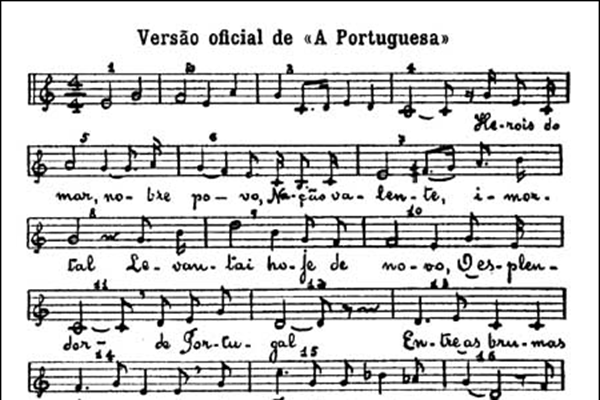- Article 11 paragraphs 1 and 2 of the Constitution says:
- The National Flag, which shall be the symbol of the sovereignty of the Republic and of Portugal’s independence, unity and integrity, shall be that adopted by the Republic formed by the Revolution of 5 October 1910.
- The National Anthem shall be A Portuguesa.
-
As far as ordinary legislation is concerned, mention should be made of Decree-Law n. 150/87 of 30 March, which regulated the use of the National Flag on national territory, with the exception only of specific military and maritime norms. The National Flag may be used on all national territory (article 2, n. 1), and it is determined that it must conform to the “official pattern” (as defined in article 11 of the Constitution) and kept in a good state of repair (article 2, n. 2), and must be raised on “Sundays, holidays and on days of official ceremonies or other solemn acts or sessions of a public nature” (article 3, n. 1).
Furthermore, the Government, the bodies of the governments of the autonomous regions, civil governors, executive bodies of the local authorities and the heads of private institutions may order the National Flag to be flown (article 3, n. 2). Finally, on buildings that are the seat of organs of sovereignty the National Flag may be flown daily by right (article 3, n. 3). The National Flag shall be flown between 9 am and sunset and if flown at night shall whenever possible be spotlighted (article 6, n. 1 and 2). During periods of national mourning the National Flag shall be flown at half-mast (article 7, n. 1). Finally, it must be said that when flown with other Portuguese or foreign flags, the National Flag shall always occupy the place of honour (article 8).
-
The national symbols are legal assets subject to penal supervision. In 1910, article 3 of the decree having force of law of 28 December determined that “whosoever fails in the respect owed to the National Flag that is the symbol of the Nation in speech or in published writings or otherwise by other means of publication, shall be sentenced to a prison sentence of three months to one year and the corresponding fine, and in case of relapse the minimum sentence shall be expulsion from national territory, as per article 62 sole § of the Penal Code”.
At present, article 332 of the Penal Code establishes a penalty of imprisonment of up to two years or a fine of up to 240 days “for all those who publicly, through words, gestures or in writing or through any other means of communication with the public, offend the Republic, the National Flag or the National Anthem, the Arms and Emblems of Portuguese sovereignty, or failing to respect them”; in the case of regional symbols, the penalty is imprisonment of up to one year or a fine of up to 120 days.
National Symbols Files
Introduction
Updated: 07 of January of 2022
National Flag
Updated: 07 of January of 2022
The colours red and green, as adopted by the Republican Government in 1910, refer to the movement of 31 January 1891. On 5 October they were used by Machado Santos at the Rotunda and later in all army barracks and at the top of St. George’s Castle (although the colours were disposed differently from today, red being on the hoist side and green being the larger portion).
The issue of the national symbols was one of the first priorities of the Provisional Government formed after 5 October 1910.
By decree of 15 October 1910 the Government appointed a commission which included such personalities as Columbano Bordalo Pinheiro, Abel Botelho and João Chagas. A few days later, on 29 October, the commission submitted a first project, similar to the flag of 5 October with one important difference – the disposition of the colours was inverted and the colour green was now next to the hoist. As for the arms, the commission suggested the armillary sphere, “the eternal standard of our adventurous spirit”, and the white shield with the blue escutcheons of the “foundation of our nationality”. A second project was presented that maintained the red and green and the Government approved it on 29 November 1910.
At its opening session the National Constituent Assembly decreed the monarchy abolished and at the same time sanctioned the project approved by the Government for the National Flag and the National Anthem (see Actas da Assembleia Nacional Constituinte de 1911, Lisbon, 1986, p. 15).
The decree of 19 June 1911 of the National Constituent Assembly, established:
“1st - The National Glag is divided vertically into two fundamental colours, dark green and scarlet, with the green at the hoist. Centred on the dividing line is the shield with the national arms, circled in white and set onto the Manueline armillary sphere, in yellow with black bordering. The dimensions and other details concerning the design, specialisation and decoration of the flag shall be as determined by the commission appointed by decree of 15 October 1910, and shall be immediately published in the Diário do Governo (Official Government Gazette).
2nd - The national anthem is A Portuguesa.” (see Diário do Governo, n. 141 of 20 June 1911, p. 2601).
Days later the technical opinion on the measurements and proportions of the National Flag were published, together with those of regimental flags and Jacks for the ships (see Diário do Governo, n. 150 of 30 June 1911, pp. 2756-2757).
National Anthem
Updated: 06 of February of 2024
The National Anthem is the other national symbol defined in article 11 of the Constitution. With music by Alfredo Keil and words by Henrique Lopes de Mendonça, “A Portuguesa” was composed in the emotional aftermath of the Ultimatum and became the march of the rebellion of 31 January. It was certainly for this reason that it was forbidden by the monarchy.
The 5 October 1910 revolution recovered it and on 17 November the War Ministry determined that whenever the anthem “A Portuguesa” was played all military personnel present in uniform should salute and if in civilian clothes should bare their heads, in both cases remaining upstanding until it ended.
However, approval of the official version only came in 1957 through a resolution of the Council of Ministers published in Diário do Governo, 1st series, n. 199 of 4 September 1957. As a result, a version for symphony orchestra was produced by Frederico de Freitas and on the basis of this a military band version was developed by Major Lourenço Alves Ribeiro, inspector of military bands.
|
|
A Portuguesa Heróis do mar, nobre povo, / Heroes of the sea, noble people, Às armas, às armas! / To arms, to arms! Composers Alfredo Keil, Henrique Lopes de Mendonça |
Legislation
Updated: 07 of January of 2022
You can access here the legislation related to the theme.
Files
Updated: 07 of January of 2022
You can access the files related to the theme here.



